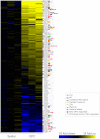Divergent targets of Candida albicans biofilm regulator Bcr1 in vitro and in vivo
- PMID: 22544909
- PMCID: PMC3416506
- DOI: 10.1128/EC.00103-12
Divergent targets of Candida albicans biofilm regulator Bcr1 in vitro and in vivo
Abstract
Candida albicans is a causative agent of oropharyngeal candidiasis (OPC), a biofilm-like infection of the oral mucosa. Biofilm formation depends upon the C. albicans transcription factor Bcr1, and previous studies indicate that Bcr1 is required for OPC in a mouse model of infection. Here we have used a nanoString gene expression measurement platform to elucidate the role of Bcr1 in OPC-related gene expression. We chose for assays a panel of 134 genes that represent a range of morphogenetic and cell cycle functions as well as environmental and stress response pathways. We assayed gene expression in whole infected tongue samples. The results sketch a portrait of C. albicans gene expression in which numerous stress response pathways are activated during OPC. This one set of experiments identifies 64 new genes with significantly altered RNA levels during OPC, thus increasing substantially the number of known genes in this expression class. The bcr1Δ/Δ mutant had a much more limited gene expression defect during OPC infection than previously reported for in vitro growth conditions. Among major functional Bcr1 targets, we observed that ALS3 was Bcr1 dependent in vivo while HWP1 was not. We used null mutants and complemented strains to verify that Bcr1 and Hwp1 are required for OPC infection in this model. The role of Als3 is transient and mild, though significant. Our findings suggest that the versatility of C. albicans as a pathogen may reflect its ability to persist in the face of multiple stresses and underscore that transcriptional circuitry during infection may be distinct from that detailed during in vitro growth.
Figures




Similar articles
-
Critical role of Bcr1-dependent adhesins in C. albicans biofilm formation in vitro and in vivo.PLoS Pathog. 2006 Jul;2(7):e63. doi: 10.1371/journal.ppat.0020063. PLoS Pathog. 2006. PMID: 16839200 Free PMC article.
-
Systematic Genetic Interaction Analysis Identifies a Transcription Factor Circuit Required for Oropharyngeal Candidiasis.mBio. 2022 Feb 22;13(1):e0344721. doi: 10.1128/mbio.03447-21. Epub 2022 Jan 11. mBio. 2022. PMID: 35012341 Free PMC article.
-
Transcription Factors Efg1 and Bcr1 Regulate Biofilm Formation and Virulence during Candida albicans-Associated Denture Stomatitis.PLoS One. 2016 Jul 25;11(7):e0159692. doi: 10.1371/journal.pone.0159692. eCollection 2016. PLoS One. 2016. PMID: 27453977 Free PMC article.
-
Candida-host interactions in HIV disease: implications for oropharyngeal candidiasis.Adv Dent Res. 2011 Apr;23(1):45-9. doi: 10.1177/0022034511399284. Adv Dent Res. 2011. PMID: 21441480 Free PMC article. Review.
-
Probiotics for Oral Candidiasis: Critical Appraisal of the Evidence and a Path Forward.Front Oral Health. 2022 Apr 14;3:880746. doi: 10.3389/froh.2022.880746. eCollection 2022. Front Oral Health. 2022. PMID: 35495563 Free PMC article. Review.
Cited by
-
Ras signaling gets fine-tuned: regulation of multiple pathogenic traits of Candida albicans.Eukaryot Cell. 2013 Oct;12(10):1316-25. doi: 10.1128/EC.00094-13. Epub 2013 Aug 2. Eukaryot Cell. 2013. PMID: 23913542 Free PMC article. Review.
-
Genomic and functional analyses unveil the response to hyphal wall stress in Candida albicans cells lacking β(1,3)-glucan remodeling.BMC Genomics. 2016 Jul 2;17:482. doi: 10.1186/s12864-016-2853-5. BMC Genomics. 2016. PMID: 27411447 Free PMC article.
-
Functional convergence of gliP and aspf1 in Aspergillus fumigatus pathogenicity.Virulence. 2018;9(1):1062-1073. doi: 10.1080/21505594.2018.1482182. Virulence. 2018. PMID: 30052103 Free PMC article.
-
Characterization of biofilm formation and the role of BCR1 in clinical isolates of Candida parapsilosis.Eukaryot Cell. 2014 Apr;13(4):438-51. doi: 10.1128/EC.00181-13. Epub 2013 Dec 2. Eukaryot Cell. 2014. PMID: 24297446 Free PMC article.
-
Candida Infections: The Role of Saliva in Oral Health-A Narrative Review.Microorganisms. 2025 Mar 23;13(4):717. doi: 10.3390/microorganisms13040717. Microorganisms. 2025. PMID: 40284554 Free PMC article. Review.
References
-
- Bensadoun RJ, Patton LL, Lalla RV, Epstein JB. 2011. Oropharyngeal candidiasis in head and neck cancer patients treated with radiation: update 2011. Support Care Cancer 19:737–744 - PubMed
-
- Brown AJ, Odds FC, Gow NA. 2007. Infection-related gene expression in Candida albicans. Curr. Opin. Microbiol. 10:307–313 - PubMed
-
- Bruno VM, et al. 2006. Control of the C. albicans cell wall damage response by transcriptional regulator Cas5. PLoS Pathog. 2:e21 doi:10.1371/journal.ppat.0020021. - DOI - PMC - PubMed
Publication types
MeSH terms
Substances
Grants and funding
LinkOut - more resources
Full Text Sources
Other Literature Sources
Molecular Biology Databases

